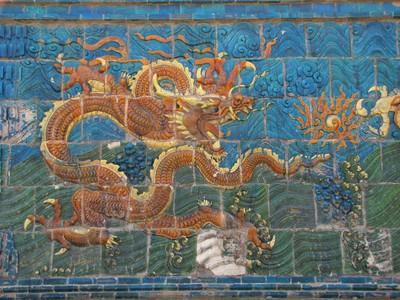Wall of the Nine Dragons
"Feng shui" means "air, water", but the combination also represents the ancient Chinese principles of organizing a house (dwelling or otherwise) in the right way. One basic principle is that the main entrance should face south (as, I am happy to report, does the entrance of my house in New Haven). This avoids some of the risk of the evil spirits that come from the north (wait a minute, where did they get that idea?). But it is not sufficient that the entrance faces south, it should also have a wall in front of it (note to self: build wall outside entrance at home in New Haven). The Wall of the Nine Dragons in Datong is the oldest such wall preserved in China.
It was built in 1392 to protect the residence of Zhu Gui, who was the thirteenth son of Zhu Yanzhang, the first emperor of the Ming dynasty. The residence itself burned down in 1644, but the wall was saved. It is huge. And the dragons are very beautiful. I have several "portrait pictures" of some of them, but the internet connection is so slow here at the hotel that those will have to wait until I am back in Beijing. So please check back, if you are interested.

According to my Baedeker (2000) the dragons are "beneficient beings, numbering nine for luck, that are dancing in the clouds, grabbing for dragon pearls."
The dragons certainly look benevolent, even cute.



Talking of Baedeker. Anyone who knows me more closely knows that I love Baedeker's travel guides, preferably from before 1914. They are still good. Even this modern one has much attention to detail, more information than flash, and good maps - all features that one is used to from the pre-war editions. And I have to use a modern one since Baedeker treated China very poorly before 1914, with only a few pages about Beijing and the Chinese places on the Manchurian branch of the Transiberian (including, however, Port Arthur) in the 1912 edition. But what has happened to Baedeker's proud tradition of flawless translations into French and English? The 2000 edition is riddled with translation errors.
It was built in 1392 to protect the residence of Zhu Gui, who was the thirteenth son of Zhu Yanzhang, the first emperor of the Ming dynasty. The residence itself burned down in 1644, but the wall was saved. It is huge. And the dragons are very beautiful. I have several "portrait pictures" of some of them, but the internet connection is so slow here at the hotel that those will have to wait until I am back in Beijing. So please check back, if you are interested.

According to my Baedeker (2000) the dragons are "beneficient beings, numbering nine for luck, that are dancing in the clouds, grabbing for dragon pearls."
The dragons certainly look benevolent, even cute.



Talking of Baedeker. Anyone who knows me more closely knows that I love Baedeker's travel guides, preferably from before 1914. They are still good. Even this modern one has much attention to detail, more information than flash, and good maps - all features that one is used to from the pre-war editions. And I have to use a modern one since Baedeker treated China very poorly before 1914, with only a few pages about Beijing and the Chinese places on the Manchurian branch of the Transiberian (including, however, Port Arthur) in the 1912 edition. But what has happened to Baedeker's proud tradition of flawless translations into French and English? The 2000 edition is riddled with translation errors.
Kommentarer
Trackback
